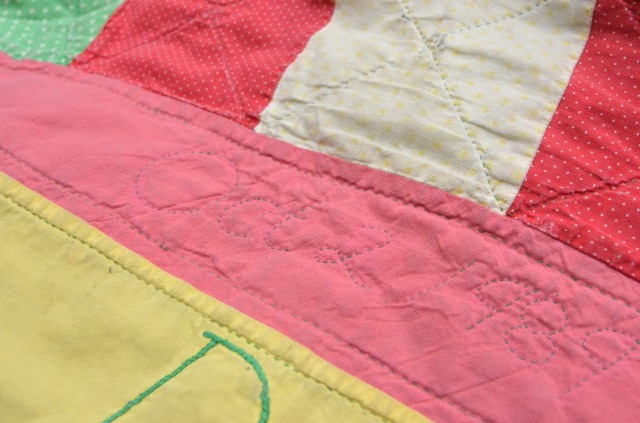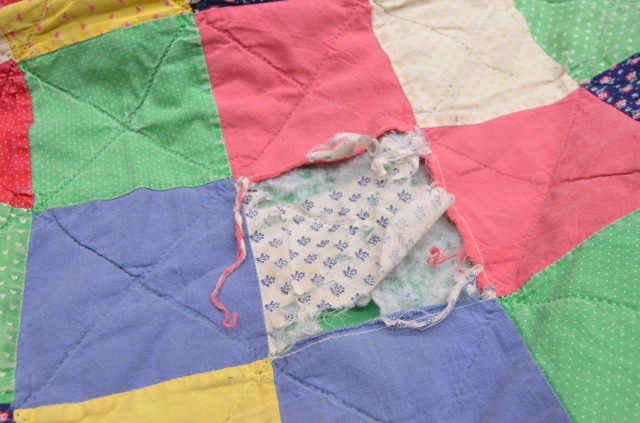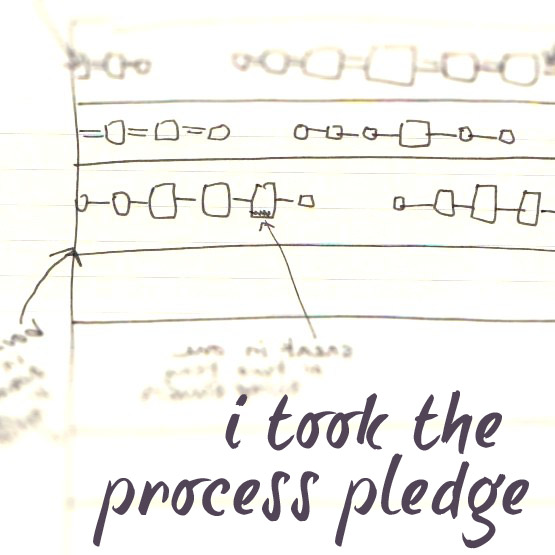They really do talk if you take the time to listen. And while this quilt is not that it is “that” old, it still speaks volumes. 1989 was not that long ago. 24 years? That’s nothing in the life of a quilt. I love going to quilt shows and especially when they show off old quilts. I mean the really old quilts, the ones that look as if they must have been wrapped in acid free paper and rolled instead of folded. They are still pristine after 100 years? How can that be?? But just because it is no older than it is it does not diminish what it has to say.
When you gift a quilt and tell the person to use and enjoy it you never know just how much they will take it to heart.
This quilt belongs to my son. He received it, from his grandmother, for his 11th birthday. As long as he was living at home it was on the end of his bed. He wrapped up in it in the evenings, after his shower and watched television. I can still picture him as that little boy, with the wet head and his quilt tucked up under his chin watching TV. So over Christmas when he asked me if I could do anything to fix his quilt I was a little surprised at his continued use of it, after all these years. This is still his every single day quilt. This is his recliner quilt. This is his TV watching quilt. I’m sure Grandma Sue had no idea how much use this quilt would get!
One reason for its softness is that there is nothing left between some of the blocks. The batting has just disintegrated. Sometimes the quilting is only thing holding a quilt together.
This is the reason 10 stitches per inch is so important. Big stitch quilting might be easier and artistic looking, but it won’t hold a quilt together like tiny ones will. And boy could she make not only tiny, but consistently tiny stitches!
On piecing battings – no matter how well they are pieced, they can still come apart. Who knew?
On binding – when old school quilters talk about hand stitched binding, generally we think about it being sewn on by machine, flipped to the back and stitched down by hand. But the hard-core actually hand stitch it with a running stitch to the front fabric.
And then wrap it around, turn it under 1/4 inch and attach it to the back with a slipstitch.
A sad thing about this method is that it is often done with a single layer of fabric. And though this same fabric is featured throughout the quilt front, and is in decent condition, it couldn’t stand up as a single layer binding, it split right down the center.
As I’ve studied this quilt, trying to figure out what to do with it, I had to ask myself why does this quilt look like it does, when so many other quilts can make it to 100 years old and still look respectable?
My best guess? This is a polyester batting and I suspect that over time it has acted like a scouring pad and abraded the fabric. And even though these fabrics all came from a quilt shop, some are obviously a higher quality than others. In the 1989 era, we weren’t using heavier fabrics, like the feedsacks of the 30s, or even our current Kona fabrics. The fabrics of that time are just not what we had early on or currently. I think there was a slip of quality for a few decades, if you ask me. I know, because I still have a lot of that fabric and have to be careful with what I use it in.
I also suspect polyester or a polyester blend thread was used in the piecing by way of how the fabric has disintegrated at some of the seam lines.
Another way to age a quilt quickly is to throw it in the washer and dryer frequently. But when you are using a quilt everyday, it is going to get washed pretty often, too. Now the scouring pads really go to work, from the inside out.
Then it all clicked with me, and how many quilts I have gifted, that I used polyester batting in, possibly polyester piecing thread and I never thought to warn the recipients. Although I always hope my quilts will be used, loved and enjoyed, they really are no different that clothing. The more you wash them the shorter their lifespan is.
And while I handle, study and try to figure out what my next step will be in “fixing” this quilt, I can totally appreciate how much this quilt has been used and loved. It is the thinnest, softest, most loved quilt I think I have ever handled.
And that is why we quilt. There is nothing quite like snuggling under a hand stitched quilt.
I’m really tempted to propose a trade and keep this one for myself….




















This really rings true to me. I have just finished restoring a baby quilt my mother made for my so forty years ago. Unfortunately, she always used cheap thread and that was the first to go. All six quilts she made for my kids had to be repaired for their kids to use. (But it is worth the effort because all my kids cherish those quilts.
LikeLike
Maybe you will share to what extent you restored your quilts?
LikeLike
The best quilts are the older, old fashioned ones. They have lots of great stories behind them and the fabrics used are precious. They’re also great memorabilia especially when they’ve been restored. I can hardly wait to see what I believe is going to be a Masterpiece. Be Blessed, Mtetar
LikeLike
I love this post. I can just imagine your son as a little boy wrapped in his quilt 🙂 and so precious that he would live it restored now. Thanks for sharing this story and good luck with the restoration 🙂
LikeLike
What a lovely post. Your words expressed all the love and care that all quilters hope their quilt will bring to the recipient. Happy Mother’s Day to you for a lovely story!
LikeLike
Fascinating post. I have only been quilting a few years but would love to think that the quilts I made my boys will be loved as much as this one clearly has.
I have also made a note to myself to use cotton batting in future!
LikeLike
Pingback: Thousand Pyramids quilt | Sewfrench